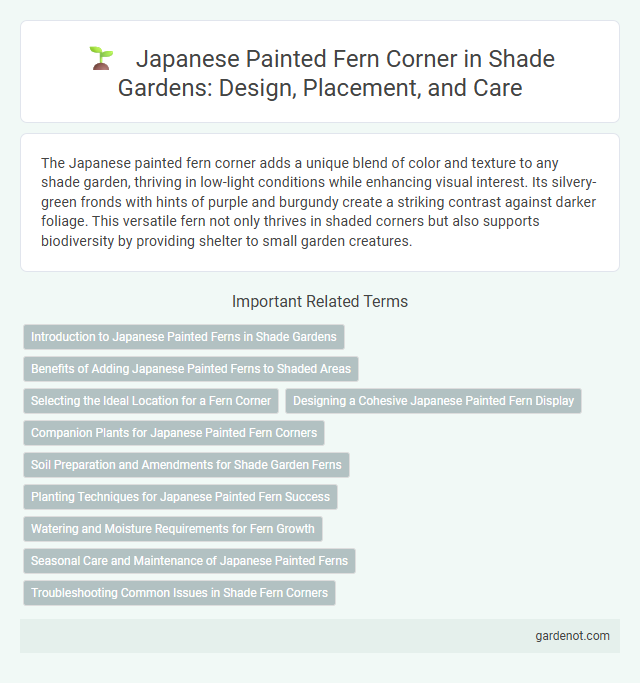The Japanese painted fern corner adds a unique blend of color and texture to any shade garden, thriving in low-light conditions while enhancing visual interest. Its silvery-green fronds with hints of purple and burgundy create a striking contrast against darker foliage. This versatile fern not only thrives in shaded corners but also supports biodiversity by providing shelter to small garden creatures.
Introduction to Japanese Painted Ferns in Shade Gardens
Japanese Painted Ferns (Athyrium niponicum) thrive in shaded garden corners, offering silvery-gray fronds with purple and green hues that enhance low-light areas. These ferns prefer moist, well-drained soil rich in organic matter, making them ideal for woodland-themed shade gardens. Their elegant, colorful foliage provides year-round interest and contrasts beautifully with darker green plants.
Benefits of Adding Japanese Painted Ferns to Shaded Areas
Japanese painted ferns enhance shaded garden corners with their unique silvery-green fronds and deep burgundy stems, providing year-round visual interest and texture. Their tolerance for low light and moisture-retentive soil improves biodiversity by attracting beneficial insects and supporting local ecosystems. These ferns also help control soil erosion, making them an excellent natural solution for stabilizing shaded slopes and damp garden beds.
Selecting the Ideal Location for a Fern Corner
The ideal location for a Japanese painted fern corner in a shade garden requires consistent moisture and dappled sunlight to maintain vibrant frond coloration. Planting in well-drained, humus-rich soil under deciduous trees ensures protection from harsh afternoon sun while providing morning light. Choosing a sheltered spot away from strong winds enhances the fern's delicate foliage and promotes healthy growth throughout the growing season.
Designing a Cohesive Japanese Painted Fern Display
Creating a cohesive Japanese painted fern display involves grouping ferns with varying shades of silver, green, and burgundy to enhance their natural color contrasts. Incorporate complementary shade-loving plants like hostas and astilbes to add texture and depth while maintaining a balanced and tranquil shade garden. Positioning the ferns near a shaded water feature or along a woodland path emphasizes their delicate fronds and supports a harmonious, serene outdoor retreat.
Companion Plants for Japanese Painted Fern Corners
Hostas and astilbes thrive in the cool, moist conditions ideal for Japanese painted fern corners, enhancing texture and color contrast. Heuchera, with its vibrant foliage, complements the delicate silver-green fronds of the Japanese painted fern, creating visual interest throughout the shade garden. Fern allies such as bleeding hearts and Solomon's seal provide height variation and seasonal blossoms, enriching the dappled shade environment.
Soil Preparation and Amendments for Shade Garden Ferns
Japanese painted ferns thrive in well-drained, humus-rich soil with a slightly acidic to neutral pH range of 6.0 to 7.0, ideal for shade garden environments. Incorporate organic matter such as leaf mold or compost to enhance moisture retention and improve soil structure, critical for these ferns' delicate root systems. Avoid heavy clay soils and ensure consistent moisture by mulching with pine needles or shredded bark to maintain soil acidity and protect roots from temperature fluctuations.
Planting Techniques for Japanese Painted Fern Success
Choose a well-drained, humus-rich soil with consistent moisture for planting Japanese Painted Ferns to ensure healthy growth and vibrant foliage. Position the plants in partial to full shade to protect their delicate fronds from direct sunlight, which can cause browning and stress. Incorporate organic mulch around the base to retain soil moisture and regulate temperature, promoting a thriving shade garden environment.
Watering and Moisture Requirements for Fern Growth
Japanese painted fern thrives in consistently moist, well-drained soil that retains humidity without becoming soggy, essential for its vibrant foliage and healthy growth. Regular watering is crucial, especially during dry periods, to maintain the moisture level around the root zone, preventing stress and browning fronds. Mulching around the base helps conserve soil moisture and regulate temperature, creating an ideal microenvironment that supports the fern's delicate water needs in a shade garden.
Seasonal Care and Maintenance of Japanese Painted Ferns
Japanese painted ferns thrive in consistently moist, well-drained soil enriched with organic matter, requiring regular watering during dry periods to maintain vibrant foliage. In early spring, apply a balanced slow-release fertilizer to encourage new growth and prune back any dead or damaged fronds to promote healthy development. Mulching with leaf litter or pine needles helps preserve soil moisture and temperature, while protecting the roots throughout seasonal changes.
Troubleshooting Common Issues in Shade Fern Corners
Japanese painted fern corners often face challenges such as powdery mildew, rust, and improper moisture levels that can hinder growth. Ensuring well-drained, consistently moist soil and adequate airflow helps prevent fungal diseases, while monitoring for pests like aphids and slugs protects delicate fronds. Regularly removing damaged leaves and providing partial to full shade conditions optimize the health and vibrancy of these shade garden ferns.
Japanese painted fern corner Infographic

 gardenot.com
gardenot.com